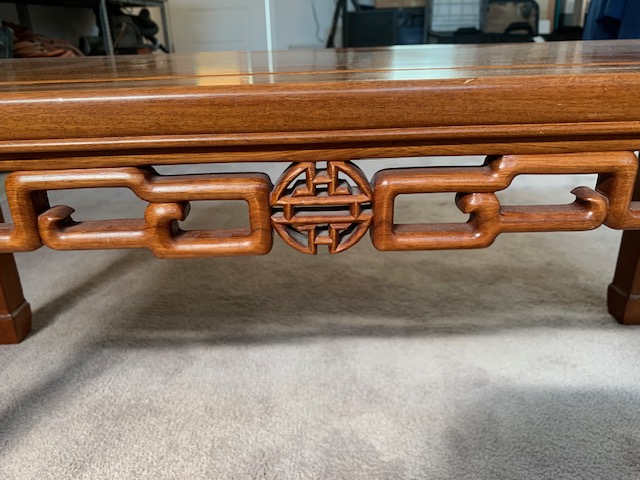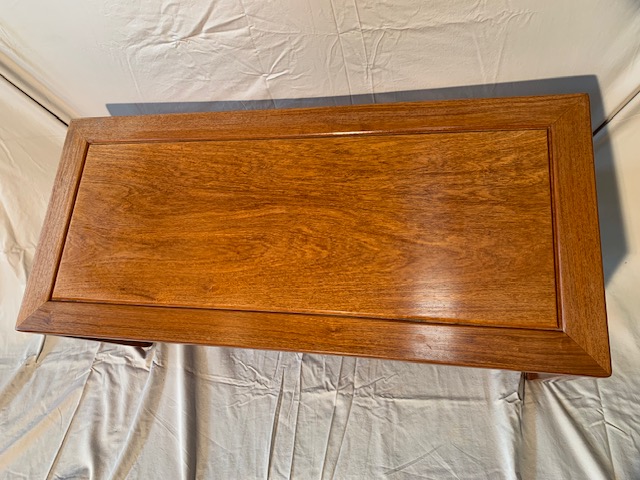-
 Huanghuali or not
Huanghuali or not  ( China & Japan ) - KK - Jan 15, 2008 (10:35 PM)
( China & Japan ) - KK - Jan 15, 2008 (10:35 PM)  Re: Huanghuali or not - Judy - Jan 16, 2008 (03:41 AM)
Re: Huanghuali or not - Judy - Jan 16, 2008 (03:41 AM)
 Re: Huanghuali or not
Re: Huanghuali or not  - pipane - Jan 16, 2008 (04:58 AM)
- pipane - Jan 16, 2008 (04:58 AM)  Re: Huanghuali or not
Re: Huanghuali or not  - kk - Jan 16, 2008 (08:18 PM)
- kk - Jan 16, 2008 (08:18 PM)
 Re: Huanghuali or not - Larry - Jan 16, 2008 (02:45 PM)
Re: Huanghuali or not - Larry - Jan 16, 2008 (02:45 PM)  Re: Huanghuali or not - kk - Jan 17, 2008 (03:06 AM)
Re: Huanghuali or not - kk - Jan 17, 2008 (03:06 AM)  Re: Huanghuali or not - Larry - Jan 17, 2008 (02:25 PM)
Re: Huanghuali or not - Larry - Jan 17, 2008 (02:25 PM)  Re: Huanghuali or not - kk - Jan 18, 2008 (01:57 AM)
Re: Huanghuali or not - kk - Jan 18, 2008 (01:57 AM)  Re: Huanghuali or not - Larry - Jan 18, 2008 (02:46 PM)
Re: Huanghuali or not - Larry - Jan 18, 2008 (02:46 PM)
 Re: Huanghuali or not
Re: Huanghuali or not  - Larry - Jan 18, 2008 (08:35 PM)
- Larry - Jan 18, 2008 (08:35 PM)
 Re: Huanghuali or not
Re: Huanghuali or not  - Larry - Jan 18, 2008 (08:42 PM)
- Larry - Jan 18, 2008 (08:42 PM)
 Re: Huanghuali or not
Re: Huanghuali or not  - Larry - Jan 18, 2008 (09:18 PM)
- Larry - Jan 18, 2008 (09:18 PM)  Re: Huanghuali or not - wingchuntaiji - Jan 22, 2008 (06:21 PM)
Re: Huanghuali or not - wingchuntaiji - Jan 22, 2008 (06:21 PM)
 Re: Huanghuali or not - Côme - Aug 03, 2017 (03:57 AM)
Re: Huanghuali or not - Côme - Aug 03, 2017 (03:57 AM)  Re: Huanghuali or not
Re: Huanghuali or not  - Côme - Aug 04, 2017 (06:42 AM)
- Côme - Aug 04, 2017 (06:42 AM)
 Re: Huanghuali or not
Re: Huanghuali or not  - Soehandi - Jan 19, 2008 (10:59 AM)
- Soehandi - Jan 19, 2008 (10:59 AM)  Re: Huanghuali or not
Re: Huanghuali or not  - kk - Jan 22, 2008 (02:19 AM)
- kk - Jan 22, 2008 (02:19 AM)  Re: Huanghuali or not - wingchuntaiji - Jan 22, 2008 (06:11 PM)
Re: Huanghuali or not - wingchuntaiji - Jan 22, 2008 (06:11 PM)  Re: Huanghuali or not - kk - Jan 23, 2008 (11:53 AM)
Re: Huanghuali or not - kk - Jan 23, 2008 (11:53 AM)  Re: Huanghuali or not - wingchuntaiji - Jan 23, 2008 (10:44 PM)
Re: Huanghuali or not - wingchuntaiji - Jan 23, 2008 (10:44 PM)
 Re: Huanghuali or not - Larry - Jan 23, 2008 (02:23 PM)
Re: Huanghuali or not - Larry - Jan 23, 2008 (02:23 PM)  Re: Huanghuali or not - wingchuntaiji - Jan 23, 2008 (11:04 PM)
Re: Huanghuali or not - wingchuntaiji - Jan 23, 2008 (11:04 PM)
 Re: Huanghuali or not
Re: Huanghuali or not  - Larry - Jan 24, 2008 (02:07 AM)
- Larry - Jan 24, 2008 (02:07 AM)  Re: Huanghuali or not - wingchuntaiji - Jan 24, 2008 (12:51 PM)
Re: Huanghuali or not - wingchuntaiji - Jan 24, 2008 (12:51 PM)
 Re: Huanghuali or not
Re: Huanghuali or not  - kk - Jan 24, 2008 (01:22 PM)
- kk - Jan 24, 2008 (01:22 PM)  Re: Huanghuali or not - Larry - Jan 25, 2008 (04:17 PM)
Re: Huanghuali or not - Larry - Jan 25, 2008 (04:17 PM)
 Re: Huanghuali or not - Larry - Jan 24, 2008 (02:08 PM)
Re: Huanghuali or not - Larry - Jan 24, 2008 (02:08 PM)  Re: Huanghuali or not - wingchuntaiji - Jan 24, 2008 (11:23 PM)
Re: Huanghuali or not - wingchuntaiji - Jan 24, 2008 (11:23 PM)
 Re: Huanghuali or not
Re: Huanghuali or not  - kk - Jan 24, 2008 (02:43 PM)
- kk - Jan 24, 2008 (02:43 PM)  Re: Huanghuali or not - wingchuntaiji - Jan 24, 2008 (11:55 PM)
Re: Huanghuali or not - wingchuntaiji - Jan 24, 2008 (11:55 PM)
 Re: Huanghuali or not - kk - Jan 25, 2008 (01:18 AM)
Re: Huanghuali or not - kk - Jan 25, 2008 (01:18 AM)  Re: Huanghuali or not - wingchuntaiji - Jan 25, 2008 (12:23 PM)
Re: Huanghuali or not - wingchuntaiji - Jan 25, 2008 (12:23 PM)  Re: Huanghuali or not
Re: Huanghuali or not  - kk - Jan 25, 2008 (10:12 PM)
- kk - Jan 25, 2008 (10:12 PM)  Re: Huanghuali or not - wingchuntaiji - Jan 27, 2008 (12:01 AM)
Re: Huanghuali or not - wingchuntaiji - Jan 27, 2008 (12:01 AM)  Re: Huanghuali or not - kk - Jan 28, 2008 (10:36 AM)
Re: Huanghuali or not - kk - Jan 28, 2008 (10:36 AM)
 Re: Huanghuali or not - Larry - Jan 29, 2008 (12:37 AM)
Re: Huanghuali or not - Larry - Jan 29, 2008 (12:37 AM)  Re: Huanghuali or not
Re: Huanghuali or not  - Dave Lee - Feb 18, 2008 (03:21 PM)
- Dave Lee - Feb 18, 2008 (03:21 PM)  None of these pieces are Huanghuali? - kk - Feb 19, 2008 (12:33 AM)
None of these pieces are Huanghuali? - kk - Feb 19, 2008 (12:33 AM)
 Re: Huanghuali or not - Kirkwood Paterson - Mar 29, 2012 (04:18 AM)
Re: Huanghuali or not - Kirkwood Paterson - Mar 29, 2012 (04:18 AM)  Re: Huanghuali or not - Tom Lyall - Oct 28, 2016 (06:28 AM)
Re: Huanghuali or not - Tom Lyall - Oct 28, 2016 (06:28 AM)
 Re: Huanghuali or not - Kirkwood Paterson - Oct 19, 2012 (06:43 AM)
Re: Huanghuali or not - Kirkwood Paterson - Oct 19, 2012 (06:43 AM)
 Re: Huanghuali or not
Re: Huanghuali or not  - Florence Tan - Sep 11, 2019 (05:05 AM)
- Florence Tan - Sep 11, 2019 (05:05 AM)
 Re: Huanghuali or not - Marcus - Mar 15, 2016 (06:31 AM)
Re: Huanghuali or not - Marcus - Mar 15, 2016 (06:31 AM)
 Re: Huanghuali or not - Roger - Apr 01, 2012 (01:34 AM)
Re: Huanghuali or not - Roger - Apr 01, 2012 (01:34 AM)
 Re: Huanghuali or not
Re: Huanghuali or not  - Roger - Apr 01, 2012 (01:46 AM)
- Roger - Apr 01, 2012 (01:46 AM)  Re: Huanghuali or not
Re: Huanghuali or not  - LEE - Apr 02, 2012 (06:42 AM)
- LEE - Apr 02, 2012 (06:42 AM)
 Re: Huanghuali or not
Re: Huanghuali or not  - LEE - Apr 02, 2012 (07:05 AM)
- LEE - Apr 02, 2012 (07:05 AM)  Re: Huanghuali or not
Re: Huanghuali or not  - Alex999 - Apr 13, 2012 (09:58 AM)
- Alex999 - Apr 13, 2012 (09:58 AM)
 Re: Huanghuali or not - trevor - Apr 09, 2014 (12:57 PM)
Re: Huanghuali or not - trevor - Apr 09, 2014 (12:57 PM)  Re: Huanghuali or not
Re: Huanghuali or not  - H-Chan - Jun 06, 2015 (12:51 AM)
- H-Chan - Jun 06, 2015 (12:51 AM)  Re: Huanghuali or not
Re: Huanghuali or not  - DAVID BARBIER - Aug 27, 2018 (04:07 PM)
- DAVID BARBIER - Aug 27, 2018 (04:07 PM)  Re: Huanghuali or not - Kosta - Dec 25, 2018 (06:20 PM)
Re: Huanghuali or not - Kosta - Dec 25, 2018 (06:20 PM)  Re: Huanghuali or not - david - Feb 07, 2019 (11:58 PM)
Re: Huanghuali or not - david - Feb 07, 2019 (11:58 PM)  Re: Huanghuali or not - Michael - Feb 18, 2019 (10:50 AM)
Re: Huanghuali or not - Michael - Feb 18, 2019 (10:50 AM)  Re: Huanghuali or not
Re: Huanghuali or not  - Pk Jain - Nov 26, 2021 (05:34 PM)
- Pk Jain - Nov 26, 2021 (05:34 PM)  Re: Huanghuali or not - MC275 - Mar 31, 2024 (10:52 PM)
Re: Huanghuali or not - MC275 - Mar 31, 2024 (10:52 PM)  Re: Huanghuali or not
Re: Huanghuali or not  - Jay Bates - Sep 12, 2024 (11:43 AM)
- Jay Bates - Sep 12, 2024 (11:43 AM)




























_(1).jpg)







